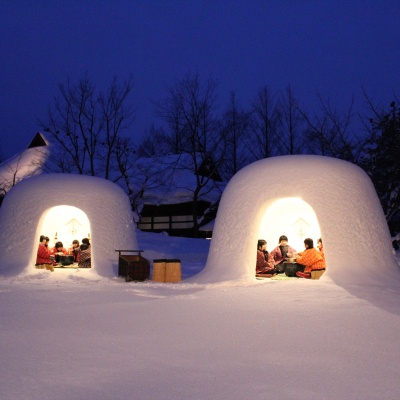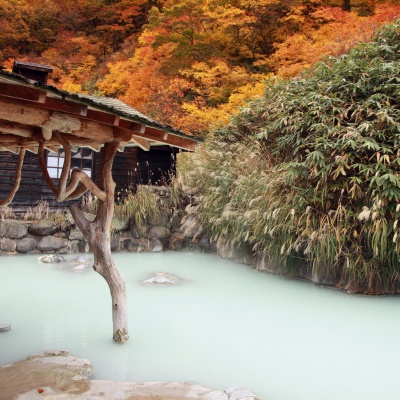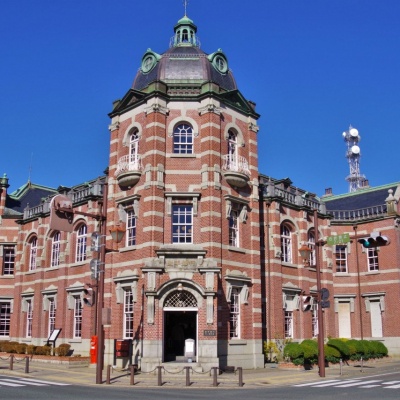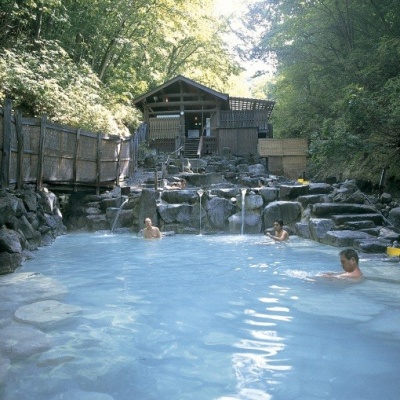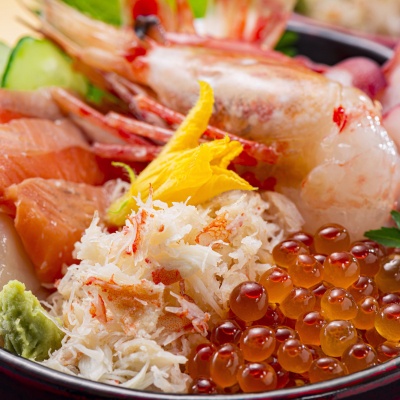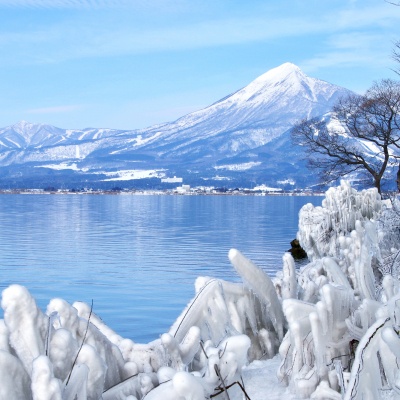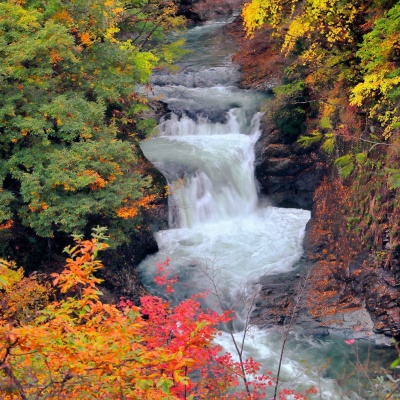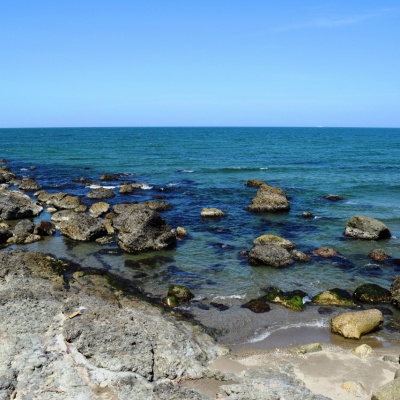3 days/2 nights based in Zao Onsen [Base! Tohoku]
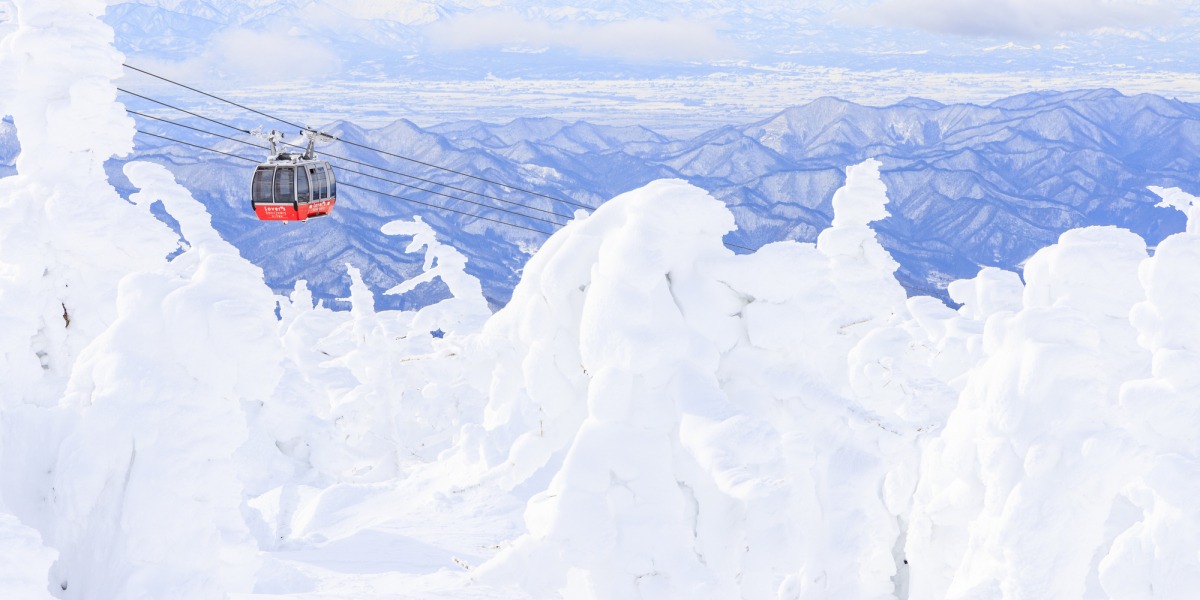
In winter, Zao is beautiful with its ice trees.
From spring to fall, visit the mysterious crater lake "Zao no Okama" with its beautiful emerald green color.
You will also visit a winery and a place associated with Kenshin Uesugi, the most powerful military commander in the Warring States period.
START
Day1
Yonezawa Castle Ruins / Matsugasaki Park
Travel back to Japan’s civil war period at this park with beautiful moats in the hometown of the Uesugi clan!
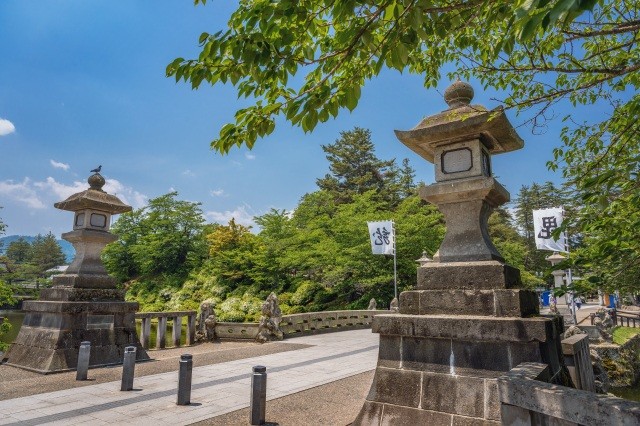
Matsugasaki Park is located on the grounds of the former Yonezawa Castle. The water-filled moats today lend a peaceful charm to the park in contrast with the castle’s turbulent history during the civil war period of many years ago. The park attracts history lovers thanks to its numerous sites related to the powerful Uesugi clan members. These included Kenshin Uesugi, one of the most powerful warriors during the civil war period of the 15th and 16th centuries, and Yozan Uesugi known for his saying “where there is a will, there is a way.” Historic attractions include the Uesugi Jinja Shrine, which today is believed to bring good luck and make wishes come true, and the treasure hall Keishoden exhibiting a number of Important Cultural Properties including relics of the Uesugi clan. There is also a stone monument indicating the birthplace of Masamune Date, the famous feudal lord known as Dokuganryu (One-Eyed Dragon).
The park is popular in spring when visitors come to view the 200 cherry blossom trees in bloom along the moats in mid to late April. Their pink flowers are particularly photogenic when reflecting on the water of the moats and make a beautiful contrast with the traditional red bridges crossing over the moats. Visitors can also enjoy magnificent autumn views when leaves of these cherry blossom trees change colours from late October to early November.
Nearby attractions include Matsugasaki Shrine enshrining Yozan Uesugi and Uesugi Joshien offering a wide range of local delicacies and crafts. Be sure to include these attractions during your visit to the park!
The park is popular in spring when visitors come to view the 200 cherry blossom trees in bloom along the moats in mid to late April. Their pink flowers are particularly photogenic when reflecting on the water of the moats and make a beautiful contrast with the traditional red bridges crossing over the moats. Visitors can also enjoy magnificent autumn views when leaves of these cherry blossom trees change colours from late October to early November.
Nearby attractions include Matsugasaki Shrine enshrining Yozan Uesugi and Uesugi Joshien offering a wide range of local delicacies and crafts. Be sure to include these attractions during your visit to the park!
Uesugi Jinja Shrine
Receive some good luck at the shrine of Kenshin Uesugi, one of the most powerful warriors of the civil war period
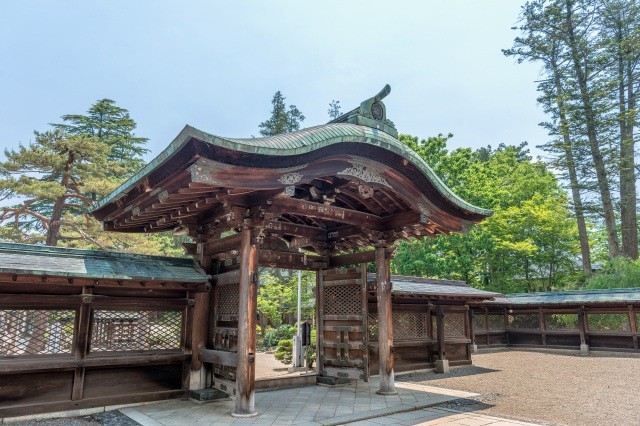
Uesugi Jinja Shrine was built on the grounds of the former Yonezawa Castle to enshrine Kenshin Uesugi, one of the most powerful warriors of the civil wars of the 15th and 16th centuries. The shrine is believed to bring good luck, academic success and thriving business thanks to Kenshin’s lingering spiritual energy.
Along the approach to the shrine, a pair of battle flags each with a Chinese character flies in the breeze on Maizuru Bridge. One has “Bi” for Bishamonten (also known as Vaisravana, the Buddhist guardian of the north) who Kenshin strongly believed in. The other has “Dragon” for Fudo Myo-o (a wrathful deity) that was used as a signal for rushing at the enemy’s position when Kenshin launched an all-out attack. Kenshin‘s firm religious faith led him to take the two most powerful deities of Buddhism to the battlefields.
History lovers should visit the treasure hall Keishoden which exhibits a number of Important Cultural Properties including relics of the Uesugi clan. There is a famous helmet of Kanetsugu Naoe, a renowned warrior and scholar, marked with the Chinese character for “Love” on display.
The shrine is located in Matsugasaki Park, a popular scenic location when the 200 cherry blossom trees lining the park moats are in bloom from mid to late April. The Yonezawa Uesugi Festival takes place at the shrine and the surrounding area from 29 April to 3 May each year. The festival’s highlights include a procession of over 1,000 shrine-parishioners dressed in extravagant samurai costumes carrying portable shrines known as Uesugi Gyoretsu, and a performance of the Battle of Kawanakajima, the biggest battle of Japan’s civil war era. The Uesugi Snow Lantern Festival takes place at the shrine and Matsugasaki Park on the weekend of the second Saturday of February each year. Over 300 candle-lit snow lanterns and 1,000 snow lamps transform the park into a winter wonderland!
The nearby Matsugasaki Shrine of Yozan Uesugi, known for the saying “where there is a will, there is a way”, also belongs to Uesugi Shrine. Visit both of the shrines for a double dose of luck!
Along the approach to the shrine, a pair of battle flags each with a Chinese character flies in the breeze on Maizuru Bridge. One has “Bi” for Bishamonten (also known as Vaisravana, the Buddhist guardian of the north) who Kenshin strongly believed in. The other has “Dragon” for Fudo Myo-o (a wrathful deity) that was used as a signal for rushing at the enemy’s position when Kenshin launched an all-out attack. Kenshin‘s firm religious faith led him to take the two most powerful deities of Buddhism to the battlefields.
History lovers should visit the treasure hall Keishoden which exhibits a number of Important Cultural Properties including relics of the Uesugi clan. There is a famous helmet of Kanetsugu Naoe, a renowned warrior and scholar, marked with the Chinese character for “Love” on display.
The shrine is located in Matsugasaki Park, a popular scenic location when the 200 cherry blossom trees lining the park moats are in bloom from mid to late April. The Yonezawa Uesugi Festival takes place at the shrine and the surrounding area from 29 April to 3 May each year. The festival’s highlights include a procession of over 1,000 shrine-parishioners dressed in extravagant samurai costumes carrying portable shrines known as Uesugi Gyoretsu, and a performance of the Battle of Kawanakajima, the biggest battle of Japan’s civil war era. The Uesugi Snow Lantern Festival takes place at the shrine and Matsugasaki Park on the weekend of the second Saturday of February each year. Over 300 candle-lit snow lanterns and 1,000 snow lamps transform the park into a winter wonderland!
The nearby Matsugasaki Shrine of Yozan Uesugi, known for the saying “where there is a will, there is a way”, also belongs to Uesugi Shrine. Visit both of the shrines for a double dose of luck!
Denkoku-no-Mori Yonezawa City Uesugi Museum
A museum that exhibits valuable articles relating to the Uesugi Clan
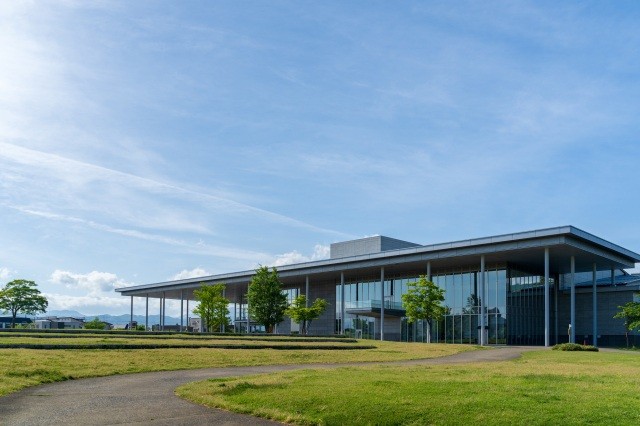
The Denkoku-no-Mori Yonezawa City Uesugi Museum is a museum adjacent to Matsugasaki Park which is also the site of the honmaru (inner citadel) of Yonezawa Castle. It holds valuable articles relating to the Uesugi Clan that flourished as warriors.
The highlight of the museum is without doubt the Uesugi Rakuchu Rakugai Zubyobu (Folding Screen) national treasure. It is said that this folding screen that depicts everyday life in Kyoto was sent by Oda Nobunaga to Uesugi Kenshin. It depicts approximately 2,500 people regardless of their social status. Furthermore, you can understand what it was like to be in Kyoto in those days because it also depicts animals, plants, famous places and festivals. Usually, a replica is on display. However, the original is exhibited for a limited time in the spring and fall when a special exhibition is held.
In addition to this, there is an exhibition that looks back at the achievements of Uesugi Yozan - the ninth feudal lord of the Yonezawa Domain who left behind the wise saying of, ""Everything that can be done must be done."" You can learn about the history of the Uesugi Clan and the culture of Yonezawa. There is a museum shop that sells original goods of Uesugi Kenshin, Uesugi Yozan and Naoe Kanetsugu. There are also items you can only purchase here.
The adjacent Matsugasaki Park is home to Uesugi Shrine where Uesugi Kenshin is enshrined and many monuments relating to the Uesugi Clan (e.g., a bronze statue of Uesugi Yozan). Please make sure to stop by when exploring the park.
A thematic journey in the Tohoku region:Art galleries・Museums
The highlight of the museum is without doubt the Uesugi Rakuchu Rakugai Zubyobu (Folding Screen) national treasure. It is said that this folding screen that depicts everyday life in Kyoto was sent by Oda Nobunaga to Uesugi Kenshin. It depicts approximately 2,500 people regardless of their social status. Furthermore, you can understand what it was like to be in Kyoto in those days because it also depicts animals, plants, famous places and festivals. Usually, a replica is on display. However, the original is exhibited for a limited time in the spring and fall when a special exhibition is held.
In addition to this, there is an exhibition that looks back at the achievements of Uesugi Yozan - the ninth feudal lord of the Yonezawa Domain who left behind the wise saying of, ""Everything that can be done must be done."" You can learn about the history of the Uesugi Clan and the culture of Yonezawa. There is a museum shop that sells original goods of Uesugi Kenshin, Uesugi Yozan and Naoe Kanetsugu. There are also items you can only purchase here.
The adjacent Matsugasaki Park is home to Uesugi Shrine where Uesugi Kenshin is enshrined and many monuments relating to the Uesugi Clan (e.g., a bronze statue of Uesugi Yozan). Please make sure to stop by when exploring the park.
A thematic journey in the Tohoku region:Art galleries・Museums
[Kaminoyama Onsen] Kaminoyama Castle Local Museum
Kaminoyama Castle was once known as the "Famous Castle of Hashu. Today, it is a bustling museum of local history.
![[Kaminoyama Onsen] Kaminoyama Castle Local Museum](/lsc/upfile/spot/0100/3392/1003392_1_m.jpg)
Kaminoyama Castle (also known as Tsukioka Castle) is said to have been built by Takei (Ei) Yoshitada in 1535 at Tenjinmori, Tsukioka.
During the Warring States period, it was the southernmost fortress of the Mogami clan and was the scene of battles with the Date and Uesugi clans in Yonezawa.
During the Edo period (1603-1867), the castle became the residence of successive lords of the Mogami clan, but it was under the Toki clan's rule that the castle, including the castle town, was developed, and the magnificent fortifications of the time were known as the "famous castle of Hashu.
However, the castle was demolished by order of the shogunate in 1692 (Genroku 5) when the Toki clan was transferred to another domain, and today only part of the moat remains.
The present Kaminoyama Castle was rebuilt in 1982 for the first time in 290 years as a local museum with a castle-style exterior.
From the observatory (castle tower), visitors can enjoy a panoramic view of the city and the Zao mountain range.
Volunteer sightseeing guides are available to show you around the museum. Please feel free to ask.
At the Kaminoyama Castle store "Kakashi Jaya", you can purchase original goods and souvenirs of Kaminoyama City.
There is also a "Kaminoyama Castle Footbath" on the premises, which you can freely enter while enjoying the view of the Zao Mountain Range.
During the Warring States period, it was the southernmost fortress of the Mogami clan and was the scene of battles with the Date and Uesugi clans in Yonezawa.
During the Edo period (1603-1867), the castle became the residence of successive lords of the Mogami clan, but it was under the Toki clan's rule that the castle, including the castle town, was developed, and the magnificent fortifications of the time were known as the "famous castle of Hashu.
However, the castle was demolished by order of the shogunate in 1692 (Genroku 5) when the Toki clan was transferred to another domain, and today only part of the moat remains.
The present Kaminoyama Castle was rebuilt in 1982 for the first time in 290 years as a local museum with a castle-style exterior.
From the observatory (castle tower), visitors can enjoy a panoramic view of the city and the Zao mountain range.
Volunteer sightseeing guides are available to show you around the museum. Please feel free to ask.
At the Kaminoyama Castle store "Kakashi Jaya", you can purchase original goods and souvenirs of Kaminoyama City.
There is also a "Kaminoyama Castle Footbath" on the premises, which you can freely enter while enjoying the view of the Zao Mountain Range.
Kaminoyama Onsen
Enjoy a healthy trip with walking and a hot spring! A hot spring district to please both your mind and body
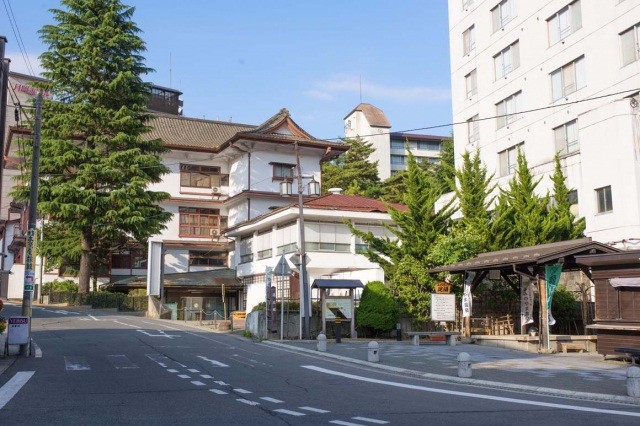
Kaminoyama Onsen is known as one of the "three pleasure resorts of Ou" along with Higashiyama Onsen and Yunohama Onsen.There are two areas with completely different atmospheres: the Niiyu, Yumachi, and Tokamachi areas, where samurai residences, warehouses, and other remnants of the castle town of the Kaminoyama clan and inn towns along the Hashu Highway remain, and the Hayama, Kawasaki, and Takamatsu areas, which are located on high ground with an excellent view overlooking the Zao mountain range.
The clear, colorless, refreshing water is said to be gentle enough for even babies to enjoy.The water is said to be effective in retaining heat and moisture, and is also known as the "hot water of beauty.Enjoy the hot springs not only at the inns where you stay, but also at the inns, public bathhouses, and footbaths where you can take a one-day trip.
Health tourism is also popular, as it allows visitors to experience all three major elements of health promotion: exercise, nutrition, and rest.The only one of its kind in Japan, there are 8 walking courses in 5 locations certified by the University of Munich in Germany.Even beginner walkers can feel comfortable participating in the daily programs led by full-time guides.Look for rare birdsong and plants, cool your arms with spring water, and so on. Playing with nature will heal your mind.After exercising, nourish your body with delicious food made from locally grown seasonal ingredients.Once your stomach is full, take a rest in a hot spring and your body will be refreshed for sure!
Quaalto: A health resort or sanatorium that uses natural remedies such as hot springs, mud, steam, sunlight, and clean air derived from the soil. In Germany, natural therapy is also covered by medical insurance.
The clear, colorless, refreshing water is said to be gentle enough for even babies to enjoy.The water is said to be effective in retaining heat and moisture, and is also known as the "hot water of beauty.Enjoy the hot springs not only at the inns where you stay, but also at the inns, public bathhouses, and footbaths where you can take a one-day trip.
Health tourism is also popular, as it allows visitors to experience all three major elements of health promotion: exercise, nutrition, and rest.The only one of its kind in Japan, there are 8 walking courses in 5 locations certified by the University of Munich in Germany.Even beginner walkers can feel comfortable participating in the daily programs led by full-time guides.Look for rare birdsong and plants, cool your arms with spring water, and so on. Playing with nature will heal your mind.After exercising, nourish your body with delicious food made from locally grown seasonal ingredients.Once your stomach is full, take a rest in a hot spring and your body will be refreshed for sure!
Quaalto: A health resort or sanatorium that uses natural remedies such as hot springs, mud, steam, sunlight, and clean air derived from the soil. In Germany, natural therapy is also covered by medical insurance.
Day2
Okama Crater of Zao
Zao’s iconic crater-lake changes hues depending on the sunlight
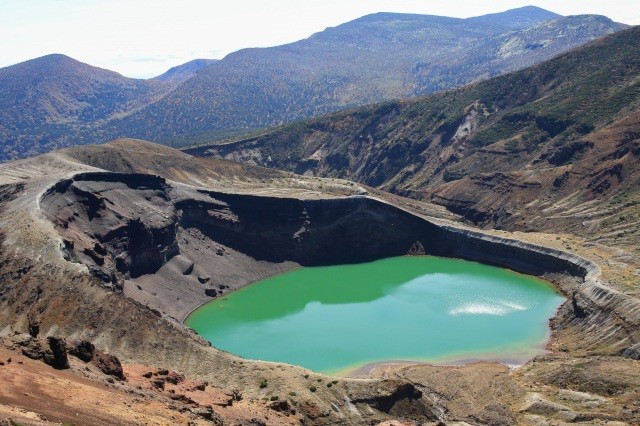
Located on the border of Miyagi and Yamagata prefectures, the Zao Mountain Range has been selected as one of Japan’s 100 most famous mountains. Okama Crater is a crater-lake surrounded by three mountains (Kattadake, Kumanodake and Goshikidake) and, along with its frost-covered trees, is an iconic image of the Zao Mountains. Nicknamed the “Cauldron” because of its appearance, Okama Crater is also known locally as “Goshikilake” (the five-coloured pond) thanks to the changing hues of the water from dark green to blue according to the sunlight. The colours of the crater-lake also fascinate visitors as they change depending on the angle of view. The lake is a kilometre in circumference, 325m in diameter, and has a depth of 27.6m. There is no life in the lake due to strong acidity of the water.
The crater is accessible via a scenic drive along the Zao Echo Line, traversing the Zao Mountains from east to west, to the Zao High Line. The Zao Summit Rest House along the way offers a restaurant and gift shop with a splendid view of Okama Crater. The Zao Echo Line and Zao High Line are open from late April to early November. Please be mindful that these mountain roads are closed during winter.
There is an easy 10-minute trail from Okama Crater to the top of Mount Kattadake (1758m) where the Kattamine Shrine stands worshipping the incarnation of Zao.
The one-hour “Umanose” trekking path leading to Mount Kumanodake offers magnificent views of Okama Crater. Be sure to wear comfortable shoes and suitable clothes.
* The roads and paths around the crater are subject to closure for safety reasons. Please refer to the Japanese Meteorological Agency’s website for the latest warnings.
The crater is accessible via a scenic drive along the Zao Echo Line, traversing the Zao Mountains from east to west, to the Zao High Line. The Zao Summit Rest House along the way offers a restaurant and gift shop with a splendid view of Okama Crater. The Zao Echo Line and Zao High Line are open from late April to early November. Please be mindful that these mountain roads are closed during winter.
There is an easy 10-minute trail from Okama Crater to the top of Mount Kattadake (1758m) where the Kattamine Shrine stands worshipping the incarnation of Zao.
The one-hour “Umanose” trekking path leading to Mount Kumanodake offers magnificent views of Okama Crater. Be sure to wear comfortable shoes and suitable clothes.
* The roads and paths around the crater are subject to closure for safety reasons. Please refer to the Japanese Meteorological Agency’s website for the latest warnings.
Zao Onsen / Zao Hot Springs
One of the oldest hot springs in Japan, opened 1,900 years ago
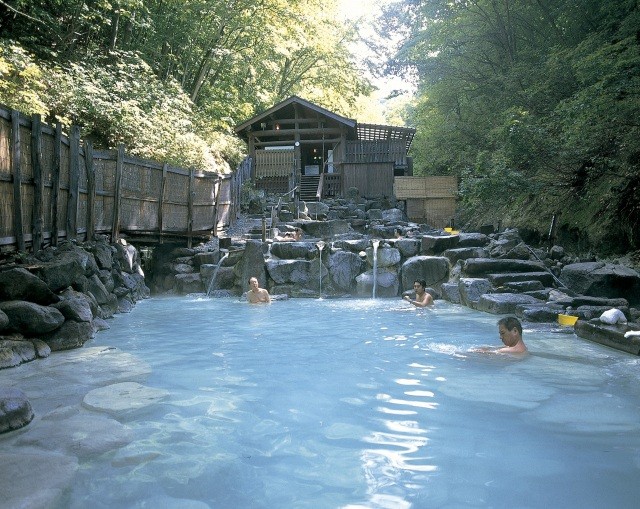
Zao Onsen was first discovered 1,900 years ago by Kibi Tagayu, who served in the army during the Japanese military expedition to the east by the Japanese warrior Takemikoto. In the Edo period (1603-1867), it became a busy western trailhead to Zao Gongen, and already had the appearance of a comprehensive resort. In the Taisho era (1912-1926), a road connecting the villages at the foot of the mountain to the hot springs was opened, and various facilities such as streetlights and a police station were installed, thus establishing a foothold as a tourist destination. In the Showa Period (1926-1989), ski resorts were opened, ropeways were installed, and sightseeing roads were opened, further establishing Zao as a tourist destination. In parallel with these developments, hotels, pensions, and guest houses opened one after another, in addition to the traditional ryokan inns. Zao has developed into one of the largest comprehensive mountain resorts in the Tohoku region.
Day3
GOAL
